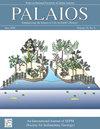热带和干旱地区蝎子的新生物学:环境对洞穴构造和形式的影响
IF 1.5
4区 地球科学
Q2 GEOLOGY
引用次数: 0
摘要
蝎子是许多陆地环境中的中间捕食者,许多蝎子是暂时或永久性的化石动物。因此,它们在陆地食物网、土壤发育和生态系统工程中扮演着重要角色。然而,由于对蝎子的痕迹形态了解不足,蝎子的化石记录很少。要纠正这种情况,关键是要评估系统发育、地理和环境上各不相同的蝎子所建造的洞穴的变异性。研究人员在不同的基质条件下,对现存的五种蝎子(Heterometrus spinifer、Pandinus imperator、Pandipalpus viatoris、Hadrurus arizonensis和Paravaejovis spinigerus)进行了新毛刺学实验。对不同物种和不同基质条件下产生的穴洞进行了描述和比较。热带蝎子挖掘沉积物,并将其带离洞穴,形成开放、笔直到连续、颠倒的隧道到分支隧道系统,其中有单个到多个入口,通常还有洞室。干旱地区的蝎子则通过快速的腿部运动进行挖掘,将沉积物抛到身体后面,从而形成单个到相连的 U 形洞穴网络,以及从垂直隧道到隧道网络,从单个到多个入口,很少有洞室。沉积物成分和湿度的变化往往会减少洞穴的生成,但不会显著改变洞穴的形态。尽管蝎子的挖掘方式和结构存在差异,但所有蝎子洞穴的相似度都在中等到高等之间,这表明无论蝎子的系统发育或环境距离如何,蝎子洞穴的形态都是一致的。这些研究结果提供了蝎子洞穴的关键图谱,可用于在化石记录中识别蝎子洞穴,并改进对古代陆地生态系统的解释。本文章由计算机程序翻译,如有差异,请以英文原文为准。
NEOICHNOLOGY OF TROPICAL AND ARID SCORPIONS: ENVIRONMENTAL IMPACTS ON BURROW CONSTRUCTION AND FORM
Scorpions are intermediate predators in numerous terrestrial environments, and many are temporarily to permanently fossorial. As a result, they play key roles in terrestrial food webs, in soil development, and as ecosystem engineers. However, scorpions have a poorly described ichnofossil record likely due to an inadequate understanding of their trace morphology. Critical to correcting this is assessing the variability of burrows constructed by phylogenetically, geographically, and environmentally distinct scorpions. Five extant scorpions, Heterometrus spinifer, Pandinus imperator, Pandipalpus viatoris, Hadrurus arizonensis, and Paravaejovis spinigerus were studied through neoichnological experiments under varying substrate conditions. Burrow casts produced were described and compared across species and different substrate conditions. Tropical scorpions excavated sediment and carried it away from the burrow to produce open, straight-to-sinuous, subvertical tunnels to branching tunnel systems with single to multiple entrances and often chambers. Arid scorpions excavated with rapid leg movements to throw sediment behind the body to produce single to linked networks of U-shaped burrows as well as subvertical tunnels to tunnel networks with single to multiple entrances and rarely chambers. Changes in sediment composition and moisture tended to reduce burrow production but did not significantly alter burrow morphology. All scorpion burrows, regardless of species, bore a moderate-to-high similarity despite differences in excavation styles and architecture suggesting that scorpions produce burrows of consistent form regardless of phylogenetic or environmental distance. The result of these studies provides key ichnotaxobases of scorpion burrows which can be used to identify them in the fossil record and improve interpretations of ancient terrestrial ecosystems.
求助全文
通过发布文献求助,成功后即可免费获取论文全文。
去求助
来源期刊

Palaios
地学-地质学
CiteScore
2.80
自引率
12.50%
发文量
40
审稿时长
6 months
期刊介绍:
PALAIOS is a monthly journal, founded in 1986, dedicated to emphasizing the impact of life on Earth''s history as recorded in the paleontological and sedimentological records. PALAIOS disseminates information to an international spectrum of geologists and biologists interested in a broad range of topics, including, but not limited to, biogeochemistry, ichnology, paleoclimatology, paleoecology, paleoceanography, sedimentology, stratigraphy, geomicrobiology, paleobiogeochemistry, and astrobiology.
PALAIOS publishes original papers that emphasize using paleontology to answer important geological and biological questions that further our understanding of Earth history. Accordingly, manuscripts whose subject matter and conclusions have broader geologic implications are much more likely to be selected for publication. Given that the purpose of PALAIOS is to generate enthusiasm for paleontology among a broad spectrum of readers, the editors request the following: titles that generate immediate interest; abstracts that emphasize important conclusions; illustrations of professional caliber used in place of words; and lively, yet scholarly, text.
 求助内容:
求助内容: 应助结果提醒方式:
应助结果提醒方式:


